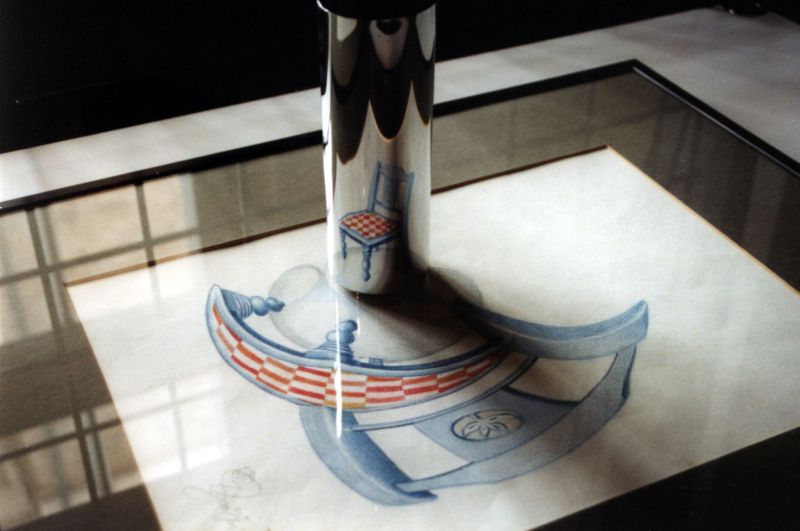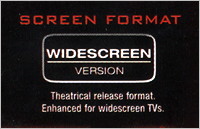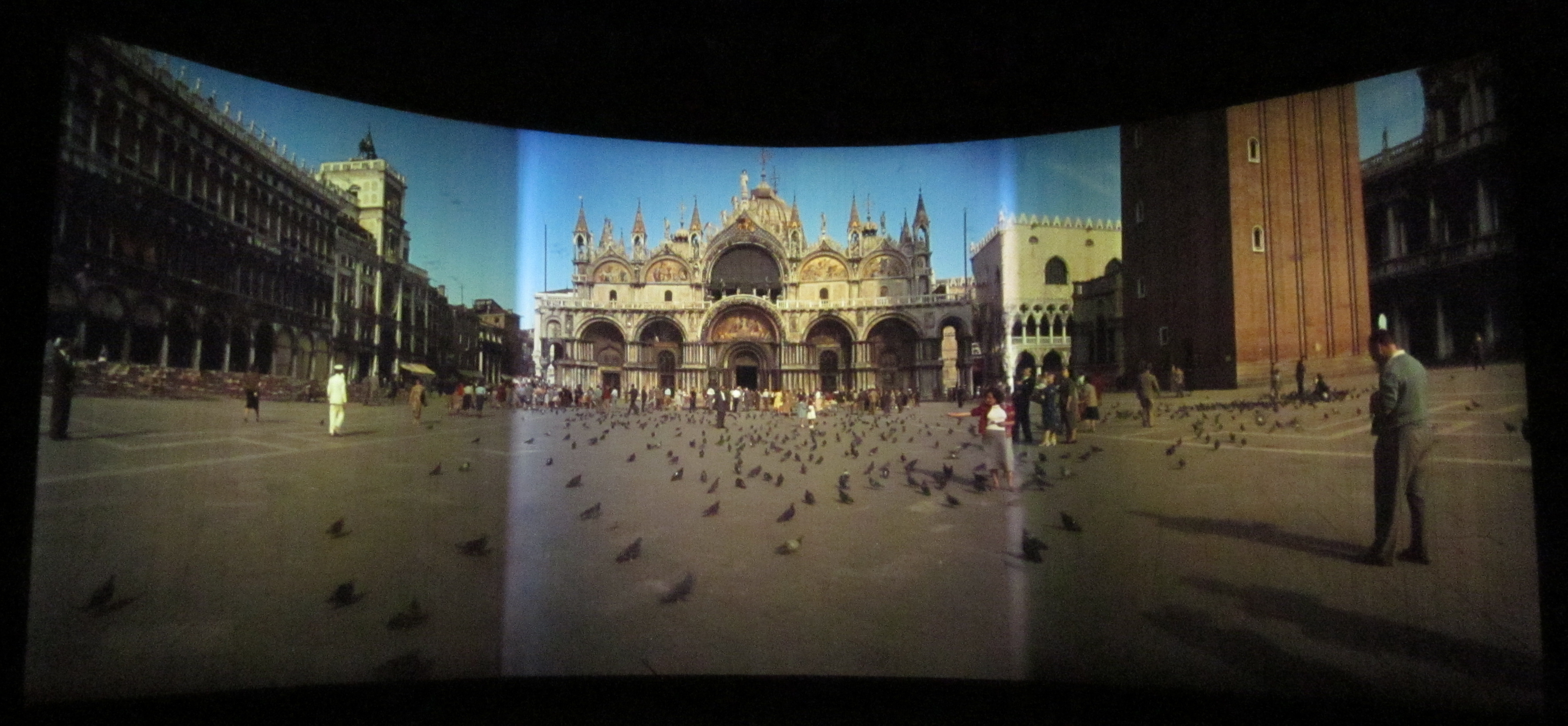|
Anamorphic
Anamorphic format is the cinematography technique of shooting a widescreen picture on standard 35 mm film or other visual recording media with a non-widescreen native aspect ratio. It also refers to the projection format in which a distorted image is "stretched" by an anamorphic projection lens to recreate the original aspect ratio on the viewing screen (not to be confused with anamorphic widescreen, a different video encoding concept that uses similar principles but different means). The word ''anamorphic'' and its derivatives stem from the Greek ''anamorphoun'' ("to transform"), compound of ''morphé'' ("form, shape") with the prefix ''aná'' ("back, against"). In the late 1990s and 2000s, anamorphic lost popularity in comparison to "flat" (or "spherical") formats such as Super 35 with the advent of digital intermediates; however, in the years since digital cinema cameras and projectors have become commonplace, anamorphic has experienced a considerable resurgence of popularit ... [...More Info...] [...Related Items...] OR: [Wikipedia] [Google] [Baidu] |
Panavision
Panavision is an American motion picture equipment company founded in 1953 specializing in cameras and lenses, based in Woodland Hills, California. Formed by Robert Gottschalk as a small partnership to create anamorphic projection lenses during the widescreen boom in the 1950s, Panavision expanded its product lines to meet the demands of modern filmmakers. The company introduced its first products in 1954. Originally a provider of CinemaScope accessories, the company's line of anamorphic widescreen lenses soon became the industry leader. In 1972, Panavision helped revolutionize filmmaking with the lightweight Panaflex 35 mm movie camera. The company has introduced other cameras such as the Millennium XL (1999) and the digital video Genesis (2004). Panavision operates exclusively as a rental facility—the company owns its entire inventory, unlike most of its competitors. Early history Robert Gottschalk founded Panavision in late 1953, in partnership with Richard Moore, ... [...More Info...] [...Related Items...] OR: [Wikipedia] [Google] [Baidu] |
Anamorphosis
Anamorphosis is a distorted projection requiring the viewer to occupy a specific vantage point, use special devices, or both to view a recognizable image. It is used in painting, photography, sculpture and installation, toys, and film special effects. The word is derived from the Greek prefix ''ana-'', meaning "back" or "again", and the word ''morphe'', meaning "shape" or "form". Extreme anamorphosis has been used by artists to disguise caricatures, erotic and scatological scenes, and other furtive images from a casual spectator, while revealing an undistorted image to the knowledgeable viewer. Types of projection There are two main types of anamorphosis: ''perspective'' (oblique) and ''mirror'' (catoptric). More complex anamorphoses can be devised using distorted lenses, mirrors, or other optical transformations. An oblique anamorphism forms an affine transformation of the subject. Early examples of Perspective (graphical), perspectival anamorphosis date to the Renaissance ... [...More Info...] [...Related Items...] OR: [Wikipedia] [Google] [Baidu] |
CinemaScope
CinemaScope is an anamorphic lens series used, from 1953 to 1967, and less often later, for shooting widescreen films that, crucially, could be screened in theatres using existing equipment, albeit with a lens adapter. Its creation in 1953 by Spyros P. Skouras, the president of 20th Century Fox, marked the beginning of the modern anamorphic format in both principal 2.55:1, almost twice as wide as the previously common Academy format's 1.37:1 ratio. Although the technology behind the CinemaScope lens system was made obsolete by later developments, primarily advanced by Panavision, CinemaScope's anamorphic format has continued to this day. In film-industry jargon, the shortened form, 'Scope, is still widely used by both filmmakers and projectionists, although today it generally refers to any 2.35:1, 2.39:1, 2.40:1, or 2.55:1 presentation or, sometimes, the use of anamorphic lensing or projection in general. Bausch & Lomb won a 1954 Oscar for its development of the CinemaScope l ... [...More Info...] [...Related Items...] OR: [Wikipedia] [Google] [Baidu] |
Anamorphic Widescreen
Anamorphic widescreen (also called Full height anamorphic or FHA) is a process by which a comparatively wide widescreen image is horizontally compressed to fit into a storage medium (photographic film or MPEG-2 standard-definition frame, for example) with a narrower aspect ratio (image), aspect ratio, reducing the horizontal resolution of the image while keeping its full original vertical resolution. Compatible play-back equipment (a projector with modified lens, or a digital video player or set-top box) can then expand the horizontal dimension to show the original widescreen image. This is typically used to allow one to store widescreen images on a medium that was originally intended for a narrower ratio, while using as much of the frame – and therefore recording as much detail – as possible. The technique comes from cinema, when a film would be framed and recorded as widescreen but the picture would be "squashed together" using a special concave lens to fit into non- ... [...More Info...] [...Related Items...] OR: [Wikipedia] [Google] [Baidu] |
35 Mm Movie Film
35 mm film is a film gauge used in filmmaking, and the film standard. In motion pictures that record on film, 35 mm is the most commonly used gauge. The name of the gauge is not a direct measurement, and refers to the nominal width of the 35 mm format photographic film, which consists of strips wide. The standard image exposure length on 35 mm for movies ("single-frame" format) is four perforations per frame along both edges, which results in 16 frames per foot of film. A variety of largely proprietary gauges were devised for the numerous camera and projection systems being developed independently in the late 19th century and early 20th century, as well as a variety of film feeding systems. This resulted in cameras, projectors, and other equipment having to be calibrated to each gauge. The 35 mm width, originally specified as inches, was introduced around 1890 by William Kennedy Dickson and Thomas Edison, using 120 film stock supplied by George Eastman. F ... [...More Info...] [...Related Items...] OR: [Wikipedia] [Google] [Baidu] |
Ultra Panavision
Ultra Panavision 70 and MGM Camera 65 were, from 1957 to 1966, the marketing brands that identified motion pictures photographed with Panavision's anamorphic movie camera lenses on 65 mm film. Ultra Panavision 70 and MGM Camera 65 were shot at 24 frames per second (fps) using anamorphic camera lenses. Ultra Panavision 70 and MGM Camera 65's anamorphic lenses compressed the image 1.25 times, yielding an extremely wide aspect ratio of 2.76:1 (when a 70 mm projection print was used). Ultra Panavision saw much less use than its sibling, the more popular Super Panavision 70, and was only used on ten films from 1957 to 1966. However, nearly fifty years later, Robert Richardson famously resurrected Ultra Panavision 70 after the lens test he came to do at the Panavision headquarters for the upcoming project with Quentin Tarantino, where he discovered that the lenses and equipment were still intact. Tarantino was fascinated by this and was able to refurbish the lenses for use in his next f ... [...More Info...] [...Related Items...] OR: [Wikipedia] [Google] [Baidu] |
Aspect Ratio (image)
The aspect ratio of an image is the ratio of its width to its height, and is expressed with two numbers separated by a colon, such as ''16:9'', sixteen-to-nine. For the ''x'':''y'' aspect ratio, the image is ''x'' units wide and ''y'' units high. Common aspect ratios are 1.85:1 and 2.39:1 in cinematography, 4:3 and 16:9 in television photography, and 3:2 in still photography. Some common examples The common film aspect ratios used in cinemas are 1.85:1 and 2.39:1.The 2.39:1 ratio is commonly labeled 2.40:1, e.g., in the American Society of Cinematographers' ''American Cinematographer Manual'' (Many widescreen films before the 1970 SMPTE revision used 2.35:1). Two common videographic aspect ratios are 4:3 (1.:1), the universal video format of the 20th century, and 16:9 (1.:1), universal for high-definition television and European digital television. Other cinema and video aspect ratios exist, but are used infrequently. In still camera photography, the most common aspect ra ... [...More Info...] [...Related Items...] OR: [Wikipedia] [Google] [Baidu] |
Widescreen
Widescreen images are displayed within a set of aspect ratios (relationship of image width to height) used in film, television and computer screens. In film, a widescreen film is any film image with a width-to-height aspect ratio greater than the standard 1.37:1 Academy aspect ratio provided by 35 mm film. For television, the original screen ratio for broadcasts was in fullscreen 4:3 (1.33:1). Largely between the 1990s and early 2000s, at varying paces in different nations, 16:9 (1.78:1) widescreen TV displays came into increasingly common use. They are typically used in conjunction with high-definition television (HDTV) receivers, or Standard-Definition (SD) DVD players and other digital television sources. With computer displays, aspect ratios wider than 4:3 are also referred to as widescreen. Widescreen computer displays were previously made in a 16:10 aspect ratio (e.g. 1680 × 1050), but now are usually 16:9 (e.g. 1920 × 1080). Film History Widescreen was ... [...More Info...] [...Related Items...] OR: [Wikipedia] [Google] [Baidu] |
Super 35
Super 35 (originally known as Superscope 235) is a motion picture film format that uses exactly the same film stock as standard 35 mm film, but puts a larger image frame on that stock by using the space normally reserved for the optical analog sound track. History Super 35 was revived from a similar Superscope variant known as Superscope 235, which was originally developed by the Tushinsky Brothers (who founded Superscope Inc. in 1954) for RKO in 1954. The first film to be shot in Superscope was '' Vera Cruz'', a western film produced by Hecht-Lancaster Productions and distributed through United Artists. When cameraman Joe Dunton was preparing to shoot ''Dance Craze'' in 1982, he chose to revive the Superscope format by using a full silent-standard gate and slightly optically recentering the lens port (to adjust for the inclusion of the area of the optic soundtrack -the gray track on left side of the illustration). These two characteristics are central to the format. It ... [...More Info...] [...Related Items...] OR: [Wikipedia] [Google] [Baidu] |
Cinematography
Cinematography (from ancient Greek κίνημα, ''kìnema'' "movement" and γράφειν, ''gràphein'' "to write") is the art of motion picture (and more recently, electronic video camera) photography. Cinematographers use a lens to focus reflected light from objects into a real image that is transferred to some image sensor or light-sensitive material inside a movie camera. These exposures are created sequentially and preserved for later processing and viewing as a motion picture. Capturing images with an electronic image sensor produces an electrical charge for each pixel in the image, which is electronically processed and stored in a video file for subsequent processing or display. Images captured with photographic emulsion result in a series of invisible latent images on the film stock, which are chemically " developed" into a visible image. The images on the film stock are projected for viewing the same motion picture. Cinematography finds uses in many fields of ... [...More Info...] [...Related Items...] OR: [Wikipedia] [Google] [Baidu] |
Technirama
__NOTOC__ Technirama is a screen process that has been used by some film production houses as an alternative to CinemaScope. It was first used in 1957 but fell into disuse in the mid-1960s. The process was invented by Technicolor and is an anamorphic process with a screen ratio the same as revised CinemaScope (2.35:1) (which became the standard), but it is actually 2.25:1 on the negative.https://www.widescreen.org/aspect_ratios.shtml Technical The Technirama process used a film frame area twice as large as CinemaScope. This gave the former a sharper image with less photographic grain. Cameras used 35-mm film running horizontally with an 8-perforation frame, double the normal size, exactly the same as VistaVision. VistaVision cameras were sometimes adapted. Technirama used 1.5:1 anamorphic curved mirror optics in front of the camera lens (unlike CinemaScope's cylindrical lenses which squeezed the image in a 1:2 ratio). In the laboratory, the 8-perforation horizontal negative woul ... [...More Info...] [...Related Items...] OR: [Wikipedia] [Google] [Baidu] |
Cinerama
Cinerama is a widescreen process that originally projected images simultaneously from three synchronized 35mm projectors onto a huge, deeply curved screen, subtending 146° of arc. The trademarked process was marketed by the Cinerama corporation. It was the first of a number of novel processes introduced during the 1950s, when the movie industry was reacting to competition from television. Cinerama was presented to the public as a theatrical event, with reserved seating and printed programs, and audience members often dressed in their best attire for the evening. The Cinerama projection screen, rather than being a continuous surface like most screens, is made of hundreds of individual vertical strips of standard perforated screen material, each about inch (~22 mm) wide, with each strip angled to face the audience, so as to prevent light scattered from one end of the deeply curved screen from reflecting across the screen and washing out the image on the opposite end. ... [...More Info...] [...Related Items...] OR: [Wikipedia] [Google] [Baidu] |
_(14929131291).jpg)




.jpg)


